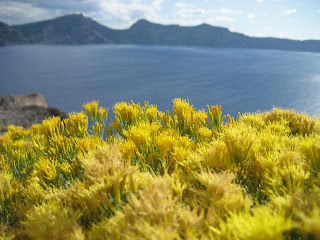





While in Glacier National Park, we ran across a couple who told us we just couldn’t go home without seeing the Redwoods. We left Crater Lake and headed south and westward to the California coast to view the tallest members of the tree family. (Giant Sequoias are bigger around, but the Redwoods have the height.) We arrived to chilly, windy weather and a fog was rolling in off the water. The fog, we found out, helps provide additional moisture for these trees during the summer months, which probably aids in their growth. It’s so amazing to be in a heavily wooded forest and then to drive into a clearing and see the Pacific Ocean—talk about the best of both worlds! Because we had heard it was difficult to stay in Redwoods National Park, we opted to stay in the nearby national forest at Panther Flats Campground, along the beautiful Smith River. It was the busy Labor Day weekend and nearly every site was full. Unfortunately, we had some rather loud-mouthed neighbors, so it was noisier than we’d have liked and I did have to sleep in my trusty earplugs. The next day we got up and drove through the park, but it was still rainy and chilly, so we didn’t hike much. The absolute grandeur of these trees as they stand in their velvety green groves takes your breath the first time you see them. You almost can’t imagine that these trees were growing in this very place when man still believed the earth was flat. David and I were spellbound by the incredible beauty of this park. The gigantic ferns carpeted the forest floor and there were lovely foot bridges along the winding pathways—I wouldn’t have been a bit surprised to catch a glimpse of fairies playing nearby. Elk frequent the park and there were numerous signs posted to warn motorists. We were fortunate to see a grazing herd one day and later saw a lone elk helping himself to some green apples in someone’s front yard! We saw many RV’s especially clustered near the lagoons and rivers. We later found out they were fishing for salmon. We hoped to buy some fresh fish but couldn’t find any, so we opted to stop at a shop which sold smoked salmon and salmon jerky. The shop was run by a native American family and they smoked their fish in the traditional way over Alder wood with simple salt and pepper. It was delicious! Naturally, we wanted enjoy the ocean, so we hiked down to the beach one day. Our path was lined with ripening blackberries and several native wildflowers, including wild pink roses. The tide was in, so we didn’t get to stroll on the beach, but viewed the pulsating water from the safety of a high rock. Another day, we took a drive to Eureka, CA which was quite a drive out of the park, but we were so very glad we made the journey. Eureka is a charming Victorian town that was quite prosperous during the height of the timber industry. There were beautiful turn-of-the-century homes and shops downtown, including a lovely renovated theatre. In addition, there’s a pleasant waterfront with a public marina and you can watch the boats come and go. We thoroughly enjoyed our time there and as we were heading out, we happened across a Canadian couple we’d met at Crater Lake. They had stopped to take a photo of a glorious Victorian home and we recognized them. We waved them over and laughed at ‘how small the world actually is!’ Pierre and Micheline were pulling a lovely airstream trailer that we had admired when we were all touring Crater Lake. They told us they were heading to Joshua Tree National Park so we said our goodbyes and wished them a safe journey. Again, we were struck by the idea that you meet such interesting and charming people when you travel.


























